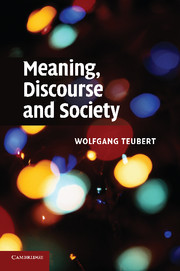Book contents
- Frontmatter
- Contents
- Acknowledgements
- Introduction
- Part I Meaning, the mind and the brain
- 1 The cognitive turn
- 2 The long history of mind linguistics
- 3 What do we know about mental concepts?
- 4 Morphing theoretical sémes into ‘real’ concepts
- 5 From mental representations to conceptual ontologies
- 6 What is meaning?
- 7 Where should we look for meaning?
- Part II Discourse and society
- Conclusion
- Bibliography
- Index
4 - Morphing theoretical sémes into ‘real’ concepts
Published online by Cambridge University Press: 04 August 2010
- Frontmatter
- Contents
- Acknowledgements
- Introduction
- Part I Meaning, the mind and the brain
- 1 The cognitive turn
- 2 The long history of mind linguistics
- 3 What do we know about mental concepts?
- 4 Morphing theoretical sémes into ‘real’ concepts
- 5 From mental representations to conceptual ontologies
- 6 What is meaning?
- 7 Where should we look for meaning?
- Part II Discourse and society
- Conclusion
- Bibliography
- Index
Summary
If we disregard Wierzbicka's mental syntax, we may well compare her semantic primes to those which were at the core of the mainstream Continental European semantic theories of the 1960s and the 1970s. Usually we trace this semantic feature theory back to Louis Hjelmslev's Prolegomena (Hjelmslev 1963 [1943]). His phonological analysis and his concept of the phoneme became the model for semantic analysis and the concept of the séme, as it quickly became popular in the linguistics of Romance languages. Bernard Pottier combined Hjelmslev's approach with the Prague school of structuralism. He was also the first to call the ‘distinctive semantic features of lexemes’ sémes. This is how he describes the meaning of chair:
chair: {s1, s2, s3, s4} (‘to sit on, on legs, for one person, with a backrest’). Relative to the set containing easy chair, chair is defined as without the séme s5 (‘with armrests’) and so on.
(Pottier 1978: 86, my translation)Thus meaning can be analysed in terms of differences, through the presence or absence of sémes. It is this focus on difference which grounds this theory in de Saussure's structuralism.
Algirdas Julien Greimas also uses the concept of sémes (Greimas 1983 [1966]: 22ff.). He distinguishes between the presence of a séme, the negation of this presence (‘negative séme’) and a state in which a given theme is neither present nor absent (‘neutral séme’).
- Type
- Chapter
- Information
- Meaning, Discourse and Society , pp. 63 - 66Publisher: Cambridge University PressPrint publication year: 2010

